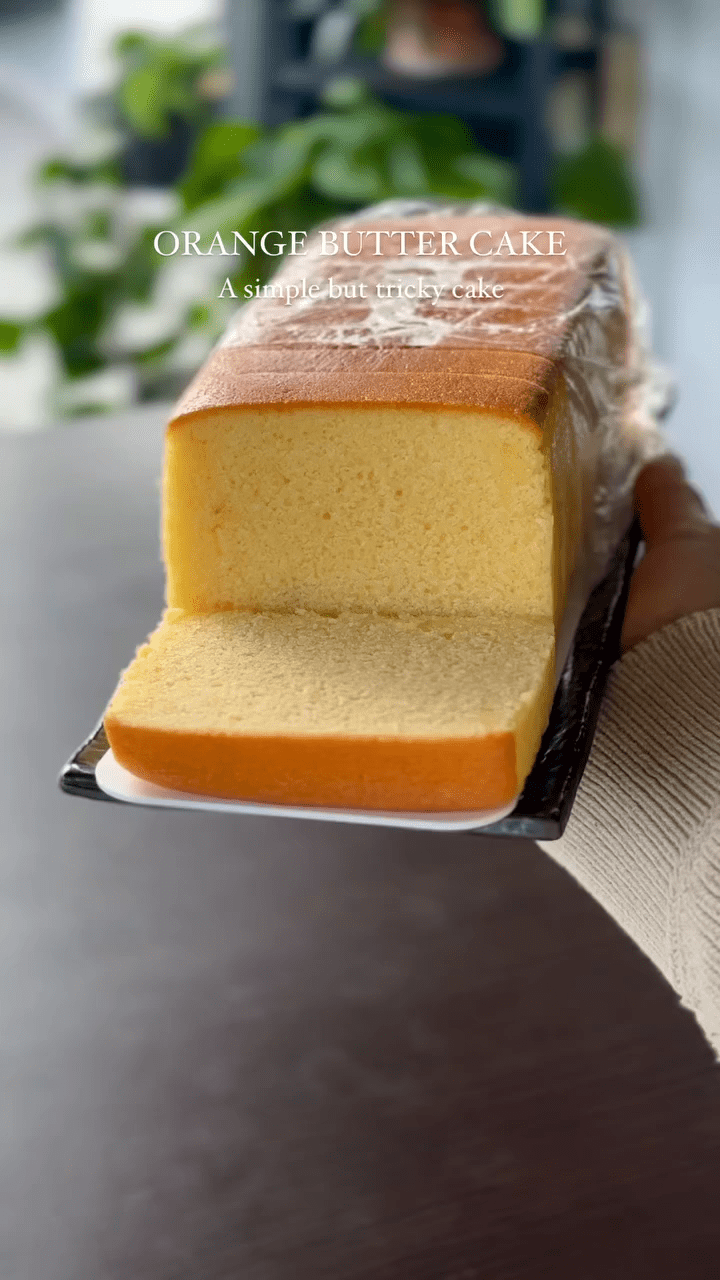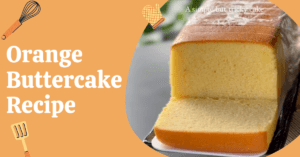There’s something undeniably comforting about a slice of buttercake. It’s rich, soft, and perfectly sweet — everything you want in a classic dessert. Now, add a touch of citrus, and you’ve got something even more special: Orange Buttercake. This version combines the lusciousness of buttercake with the bright, zesty notes of fresh orange juice and zest, creating a cake that’s both refreshing and indulgent.

Whether you’re baking for a special occasion or just in the mood for something cozy and homemade, this Orange Buttercake is the perfect choice. In this post, we’ll walk you through the recipe step by step, share pro tips to get that ideal texture, and explain why each ingredient plays an important role in the final product.
Ingredients and Their Purpose
Before diving into the method, let’s explore the ingredients and why each one matters.
200g Salted Butter (Semi-Cold 15°C): The butter is the heart of this cake. Using semi-cold butter helps control how much air is incorporated during the creaming process, giving the cake a dense but soft crumb.
170g Caster Sugar: This finer version of granulated sugar dissolves more easily into the butter during mixing, creating a smoother batter and contributing to the cake’s overall tenderness.
5 Medium Eggs: Eggs act as both a binder and leavening agent. They help trap air and give the cake structure while contributing to its richness.
180g Cake Flour: Cake flour has lower protein content compared to all-purpose flour, which leads to a lighter and softer cake texture.
1 1/2 Teaspoons Baking Powder: This chemical leavening agent ensures your cake rises evenly, producing a nice, fluffy interior.
2 Tablespoons Fresh Orange Juice: The juice adds a natural citrus flavor that cuts through the richness of the butter.
1 Teaspoon Orange Zest or Orange Flavor: Zest contains essential oils that deliver a more concentrated orange aroma than juice alone.
2 Tablespoons Full Cream Milk: Milk adds moisture and helps loosen the batter slightly, ensuring a smoother texture.
Step-by-Step Recipe
Step 1: Prepping Your Ingredients
Start by setting your butter out for about 10 minutes before baking. You want it to be around 15°C – soft enough to beat, but still cool to the touch. Preheat your oven to 170°C (338°F) and grease or line your cake mold with parchment paper.
Step 2: Creaming the Butter and Sugar
In a large mixing bowl, add the semi-cold salted butter and caster sugar. Use an electric mixer to beat them together on medium-high speed. This should take about 4-6 minutes. The mixture will become pale and creamy. Proper creaming incorporates air, which helps create a light, fluffy cake texture.
Step 3: Add the Eggs One by One
Crack your eggs into a separate bowl. Add them to the butter-sugar mixture one at a time, beating well after each addition. This step is crucial to maintain emulsion — if the mixture starts to curdle, it means the temperature of the ingredients might be too far apart. Just keep mixing. After the last egg is added, continue to beat the mixture on high speed for an additional 10 to 15 minutes. This extended mixing time allows the batter to become smooth, glossy, and full of air.
Step 4: Sift and Add the Dry Ingredients
Sift together the cake flour and baking powder. This ensures there are no lumps and helps evenly distribute the leavening agent. Add the dry ingredients into the batter in three batches, mixing gently each time. Once all the flour is added, beat the mixture for another 15 minutes on the lowest speed. Yes, it sounds like a long time, but this step helps further develop a uniform structure without overworking the batter.
Step 5: Add Orange Juice, Zest, and Milk
Fold in the fresh orange juice, orange zest (or flavoring), and full cream milk. Use a spatula or mixer on low speed to gently incorporate these final ingredients. The batter should now be silky, aromatic, and slightly thick.
Step 6: Pour and Smooth
Pour the batter into the prepared mold from a height of about 15 to 20 cm. This helps remove any large air bubbles and allows the batter to settle evenly in the pan. Give the mold a few gentle taps or shake it lightly to level the surface.
Step 7: Bake
Place the mold in the preheated oven and bake for 40 to 50 minutes, or until a skewer inserted into the center comes out clean. Every oven is slightly different, so keep an eye on it after 40 minutes.
Step 8: Cool and Serve
Let the cake rest in the pan for about 10 minutes before transferring it to a wire rack. Allow it to cool completely before slicing. This helps the cake retain its shape and prevents crumbling.
Pro Tips for a Perfect Orange Buttercake
Use a Kitchen Scale: Baking is a science, and accurate measurements matter. Always weigh your ingredients for the best results.
Don’t Rush the Mixing Process: The secret to a fluffy buttercake lies in proper creaming and mixing. Beat for the recommended times, even if it feels long.
Use Room Temperature Eggs: Cold eggs can cause the batter to curdle. Take them out of the fridge 30 minutes before baking.
Fresh Orange Juice Makes a Difference: While bottled juice works in a pinch, fresh juice offers a brighter, more natural citrus flavor.
Cake Flour is Key: Don’t substitute it with all-purpose flour unless necessary. The lower protein content ensures a finer, softer crumb.
Variations to Try
Orange Poppy Seed Buttercake: Add 1 tablespoon of poppy seeds for a bit of texture and visual appeal.
Orange Almond Buttercake: Substitute 30g of cake flour with almond flour for a nuttier flavor.
Glazed Orange Cake: Mix powdered sugar with a little fresh orange juice to create a simple glaze. Drizzle it over the cooled cake for added sweetness and shine.
Final Thoughts
This Orange Buttercake is more than just a dessert — it’s a celebration of texture, flavor, and comfort. The buttery richness balanced with the citrusy notes of orange makes it a delightful treat any time of year. Whether you serve it with tea, dress it up with whipped cream, or enjoy it plain, it’s a guaranteed crowd-pleaser.
So the next time you’re in the mood for something cozy and citrusy, give this recipe a try. With the right technique and a bit of patience, you’ll be rewarded with a cake that’s light, moist, and bursting with flavor.
Happy baking!
Must try Biscoff Caramilk Balls Recipe
Orange Buttercake Recipe

Learn how to make a moist and fluffy Orange Buttercake with fresh citrus flavor, simple ingredients, and expert baking tips for perfect results.
Type: Dessert
Cuisine: Western
Keywords: orange buttercake, citrus cake, fluffy buttercake, homemade buttercake, orange sponge cake
Recipe Yield: 1 standard loaf or 8–10 slices
Calories: Approximately 320 kcal per slice (based on 10 slices)
Preparation Time: 25 minutes
Cooking Time: 50 minutes
Total Time: 1 hour 15 minutes
Recipe Ingredients:
- 200g salted butter (semi-cold, around 15°C)
- 170g caster sugar (or granulated sugar)
- 5 medium eggs
- 180g cake flour
- 1 ½ teaspoons baking powder
- 2 tablespoons fresh orange juice
- 1 teaspoon orange zest or orange flavor
- 2 tablespoons full cream milk
Recipe Instructions:
Step 1: Prepping Your Ingredients:
Step 2: Creaming the Butter and Sugar:
Step 3: Add the Eggs One by One:
Crack your eggs into a separate bowl. Add them to the butter-sugar mixture one at a time, beating well after each addition. This step is crucial to maintain emulsion — if the mixture starts to curdle, it means the temperature of the ingredients might be too far apart. Just keep mixing. After the last egg is added, continue to beat the mixture on high speed for an additional 10 to 15 minutes. This extended mixing time allows the batter to become smooth, glossy, and full of air.
Step 4: Sift and Add the Dry Ingredients:
Sift together the cake flour and baking powder. This ensures there are no lumps and helps evenly distribute the leavening agent. Add the dry ingredients into the batter in three batches, mixing gently each time. Once all the flour is added, beat the mixture for another 15 minutes on the lowest speed. Yes, it sounds like a long time, but this step helps further develop a uniform structure without overworking the batter.
Step 5: Add Orange Juice, Zest, and Milk:
Step 6: Pour and Smooth:
Step 7: Bake:

